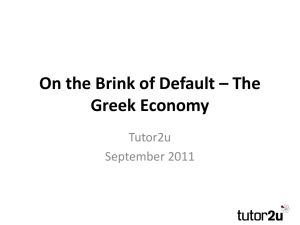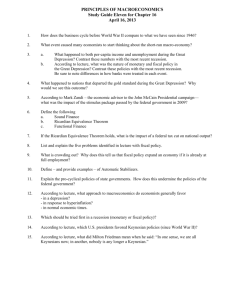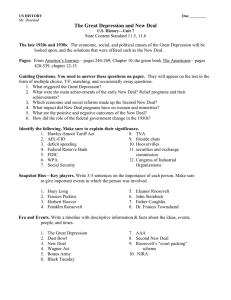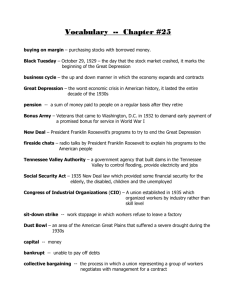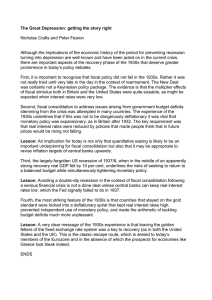Lessons of the 1930s
advertisement
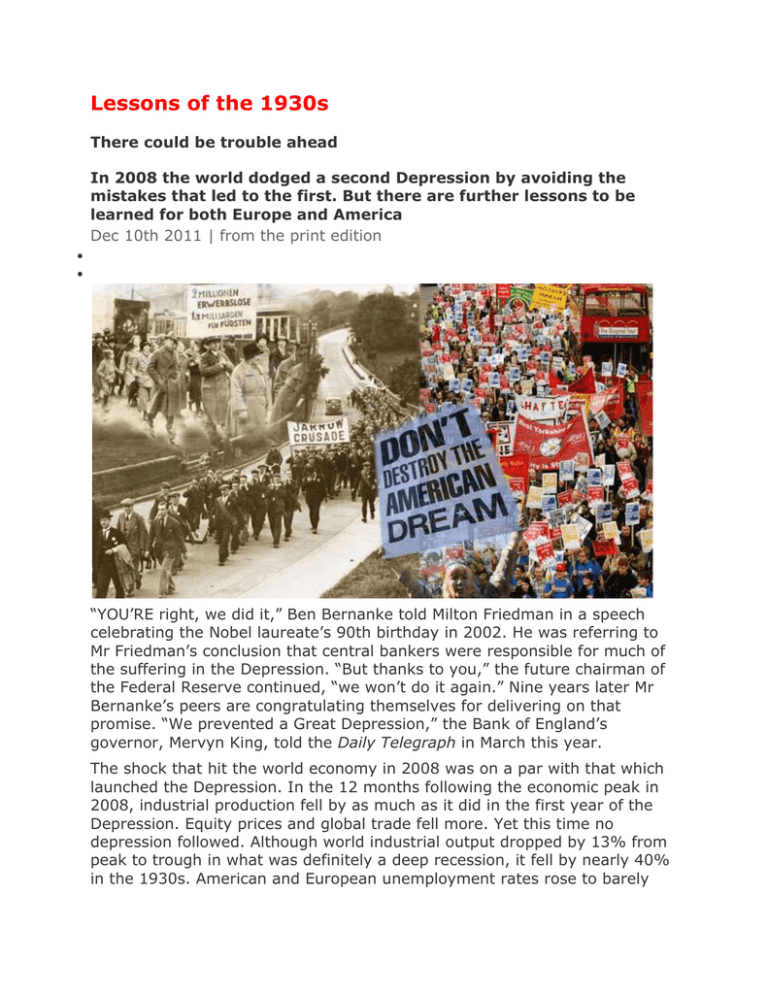
Lessons of the 1930s There could be trouble ahead In 2008 the world dodged a second Depression by avoiding the mistakes that led to the first. But there are further lessons to be learned for both Europe and America Dec 10th 2011 | from the print edition “YOU’RE right, we did it,” Ben Bernanke told Milton Friedman in a speech celebrating the Nobel laureate’s 90th birthday in 2002. He was referring to Mr Friedman’s conclusion that central bankers were responsible for much of the suffering in the Depression. “But thanks to you,” the future chairman of the Federal Reserve continued, “we won’t do it again.” Nine years later Mr Bernanke’s peers are congratulating themselves for delivering on that promise. “We prevented a Great Depression,” the Bank of England’s governor, Mervyn King, told the Daily Telegraph in March this year. The shock that hit the world economy in 2008 was on a par with that which launched the Depression. In the 12 months following the economic peak in 2008, industrial production fell by as much as it did in the first year of the Depression. Equity prices and global trade fell more. Yet this time no depression followed. Although world industrial output dropped by 13% from peak to trough in what was definitely a deep recession, it fell by nearly 40% in the 1930s. American and European unemployment rates rose to barely more than 10% in the recent crisis; they are estimated to have topped 25% in the 1930s. This remarkable difference in outcomes owes a lot to lessons learned from the Depression. Related topicsDebate continues as to what made the Depression so long and deep. Some economists emphasise structural factors such as labour costs. Amity Shlaes, an economic historian, argues that “government intervention helped make the Depression Great.” She notes that President Franklin Roosevelt criminalised farmers who sold chickens too cheaply and “generated more paper than the entire legislative output of the federal government since 1789”. Her book, “The Forgotten Man”, is hugely influential among America’s Republicans. Newt Gingrich loves it. A more common view among economists, however, is that the simultaneous tightening of fiscal and monetary policy turned a tough situation into an awful one. Governments made no such mistake this time round. Where leaders slashed budgets and central banks raised rates in the 1930s, policy was almost uniformly expansionary after the crash of 2008. Where international co-operation fell apart during the Depression, leading to currency wars and protectionism, leaders hung together in 2008 and 2009. Sir Mervyn has a point. Look closer, however, and the picture is less comforting. For in two important—and related—areas, the rich world could still make mistakes that were also made in the 1930s. It risks repeating the fiscal tightening that produced America’s “recession within a depression” of 1937-38. And the crisis in Europe looks eerily similar to the financial turmoil of the late 1920s and early 1930s, in which economies fell like dominoes under pressure from austerity, tight money and the lack of a lender of last resort. There are, in short, further lessons to be learned. Riding for a fall It was far easier to stimulate the economy in the 2000s than in the 1930s. Social safety nets—introduced in the aftermath of the Depression—mean that today’s unemployed have money to spend, providing a cushion against recession without any active intervention. States are more relaxed about running deficits, and control much larger shares of national economies. The package of public works, spending and tax cuts that President Herbert Hoover introduced after the crash of 1929 amounted to less than 0.5% of GDP. President Barack Obama’s stimulus plan, by contrast, was equivalent to 2-3% of GDP in both 2009 and 2010. Hoover’s entire budget covered only about 2.5% of GDP; Mr Obama’s takes 25% of GDP and runs a deficit of 10%. Roosevelt raised spending to 10.7% of output in 1934, by which point the American economy was growing strongly. By 1936 inflation-adjusted GDP was back to 1929 levels. Just how much the New Deal spending helped the recovery is still debated. Some economists, such as John Cochrane of the University of Chicago and Robert Barro of Harvard, say not at all. Fiscal measures never work, they say. Those who think that fiscal measures do work nonetheless tend to believe that, in the 1930s, spending was less important than monetary policy, which they see as the prime cause of suffering. In a paper in 1989 Mr Bernanke and Martin Parkinson, now the top civil servant in Australia’s finance ministry, wrote that rather than providing recovery itself “the New Deal is better characterised as having ‘cleared the way’ for a natural recovery.” Others, such as Paul Krugman, would ascribe a more positive role to stimulus spending. Whatever relative importance is assigned to monetary and fiscal policy, though, there is little doubt that their simultaneous tightening five years into the Depression led to a vicious relapse. Spurred by his treasury secretary, Henry Morgenthau—who worried in 1935 that “we cannot help but be riding for a fall unless we continue to decrease our deficit each year and the budget is balanced”—Roosevelt urged fiscal restraint on Congress in 1937. By that point the national debt had reached an unheard of 40% of GDP (huge by the standards of the day, but half what Germany’s debt is now). Congress cut spending, increased taxes and wiped out a deficit of 5.5% of GDP between 1936 and 1938. That was a larger consolidation than Greece now faces over two years (see chart 1), but is much smaller than what is planned for it in the longer term. At the same time the Federal Reserve doubled reserve requirements between mid-1936 and mid-1937, encouraging banks to pull money out of the economy. The Treasury began to restrict the money supply in step with the level of gold imports. In 1937 and 1938, the recession within a depression brought a drop in real GDP of 11% and an additional four percentage points of unemployment, which peaked at 13% or 19%, depending on how you count it. The Snowdens of yesteryear Today’s monetary policy hasn’t turned contractionary, as America’s did in the 1930s. As The Economist went to press, the European Central Bank (ECB) was expected to announce a further reduction in interest rates. But in many places fiscal policy is moving rapidly in that direction. Mr Obama’s stimulus is winding down; state- and local-government cuts continue. Republican candidates for the presidency echo the arguments of Mr Morgenthau, claiming that deficit-financed stimulus spending has done little but add to the obligations of future taxpayers. Mr Obama, like Roosevelt, has started to stress the need for budget-cutting. If the current payroll-tax cut and emergency unemployment benefits were to lapse, growth over the next year would be reduced by around one percentage point of GDP. America is not alone. Under David Cameron, Britain’s hugely indebted government introduced a harsh programme of fiscal consolidation in 2010 to avert a loss of confidence in its creditworthiness. The rationale was similar to that for chancellor Philip Snowden’s emergency austerity budget of 1931, with its tax rises and spending cuts. On that occasion confidence was not restored, and Britain was forced to devalue the pound and abandon the gold standard. On this occasion the measures have indeed boosted investor confidence, and thus bond yields; that the country still faces a second recession is in large part due to the euro zone’s woes. That said, the possibility of such shocks should always be a counsel for caution when a government embarks on fiscal tightening. Some say tightening need not hurt. In 2009 Alberto Alesina and Silvia Ardagna of Harvard published a paper claiming that austerity could be expansionary, particularly if focused on spending cuts, not tax increases. Budget cuts that reduce interest rates stimulate private borrowing and investment, and by changing expectations about future tax burdens governments can also boost growth. Others doubt it. An International Monetary Fund (IMF) study in July this year found that Mr Alesina and Ms Ardagna misidentified episodes of austerity and thus overstated the benefits of budget cuts, which typically bring contraction not expansion. Roberto Perotti of Bocconi University has studied examples of expansion at times of austerity and showed that it is almost always attributable to rising exports associated with currency depreciation. In the 1930s the contractionary impact of America’s fiscal cuts was mitigated to some extent by an improvement in net exports; America’s trade balance swung from a deficit of 0.2% of GDP to a surplus of 1.1% of GDP between 1936 and 1938. Now, most of the world is cutting budgets and not every economy can reduce the pain by boosting exports. The importance of monetary policy in the 1930s might suggest that central banks could offset the effects of fiscal cuts. In 2010 the IMF wrote that Britain’s expansionary monetary policy should mitigate the contractionary impact of big budget cuts and “establish the basis for sustainable recovery”. Yet Britain is now close to recession and unemployment is rising, suggesting limits to what a central bank can do. The move to austerity is most dramatic within the euro zone—which can least afford it. Operating without floating currencies or a lender of last resort, its present predicament carries painful echoes of the gold-standard world of the early 1930s. In the mid-1920s, after an initially untenable schedule of war reparations payments was revised, French and American creditors struck by the possibility of rapid growth in the battered German economy began to pile in. The massive flow of capital helped fund Germany’s sovereign obligations and led to soaring wages. Germany underwent a credit-driven boom like those seen on the European periphery in the mid-2000s. In 1928 and 1929 the party ended and the flow of capital reversed. First, investors sent their money to America to bet on its soaring market. Then they yanked it out of Germany in response to financial panic. To defend its gold reserves, Germany’s Reichsbank was forced to raise interest rates. Suddenly deprived of foreign money, and unable to rely on exports for growth as the earlier boom generated an unsustainable rise in wages, Germany turned to austerity to meet its obligations, as Ireland, Portugal, Greece and Spain have done. A country with a floating currency could expect a silver lining to capital outflows: the exchange rate would fall, boosting exports. But Germany’s exchange rate was fixed by the gold standard. Competitiveness could only be restored through a slow decline in wages, which occurred even as unemployment rose. As the screws tightened, banks came under pressure. The Austrian economy faced troubles like those in Germany, and in 1931 the failure of Austria’s largest bank, Credit Anstalt, triggered a loss of confidence in the banks that quickly spread. As pressure built in Germany, the leaders of the largest economies repeatedly met to discuss the possibility of assistance for the flailing economy. But the French, in particular, would brook no reduction in Germany’s debt and reparations payments. Recognising that the absence of a lender of last resort was fuelling panic, the governor of the Bank of England, Montagu Norman, proposed the creation of an international lender. He recommended a fund be set up and capitalised with $250m, to be leveraged up by an additional $750m and empowered to lend to governments and banks in need of capital. The plan, probably too modest, went nowhere because France and America, owners of the gold needed for the leveraging, didn’t like it. So the dominoes fell. Just two months after the Credit Anstalt bankruptcy a big German bank, Danatbank, failed. The government was forced to introduce capital controls and suspend gold payments, in effect unpegging its currency. Germany’s economy collapsed, and the horrors of the 1930s began. It is all dreadfully familiar (though no European country is about to elect another Hitler). Membership in the euro zone, like adherence to the gold standard, means that uncompetitive countries can’t devalue their currencies to reduce trade deficits. Austerity brings with it a vicious circle of decline, squeezing domestic demand and raising unemployment, thereby hurting revenues, sustaining big deficits and draining away confidence in banks and sovereign debt. As residents of the periphery move their money to safer banks in the core, the money supply declines, just as it did in the 1930s (see chart 2). High-level meetings with creditor nations bring no surcease. There is no lender of last resort. Though the European Financial Stability Facility (EFSF) has got further off the ground than Norman’s scheme, which it chillingly resembles, euro-zone leaders have yet to find a way to leverage its €440 billion up to €2 trillion. Even if they succeed, that may be too little to end the panic. Investors driven by turmoil in Italian markets are pre-emptively reducing their exposure to banks and sovereign bonds elsewhere in the euro zone. Even countries with relatively robust economies such as France and the Netherlands have not been spared. No matter how secure an economy’s fiscal position, a short-term liquidity crunch driven by panic can drive it into insolvency. History need not repeat itself. Norman’s Bank of England was created in the 17th century to lend to the government when necessary; central banks have always been obliged to lend to governments when others will not. The ECB could take on this role. It is prohibited by its charter from buying debt directly from governments, but it can purchase debt securities on the secondary market. It has been doing so piecemeal and could declare its intention to do so systematically. Its power to create an unlimited amount of money would allow it credibly to announce its willingness to buy any bonds markets want to sell, thus removing the main cause of panic and contagion. This week France and Germany proposed the adoption of legally binding budgetary “golden rules” by euro-zone members, ahead of a summit of European leaders in Brussels on December 8th-9th. Mario Draghi, the ECB’s new president, has hinted that were a fiscal pact to be agreed, the ECB might buy bonds on a larger scale. What scale he has in mind, though, is unclear. Jens Weidmann, president of Germany’s Bundesbank and an influential member of the ECB’s governing council, has clearly stated that the ECB “must not be” the euro zone’s lender of last resort. Where this path leads On the present course, conditions in developed economies look like getting worse before they get better. Growth in America and Britain will probably be less than 2% in 2012 on current policy, and in both recession is quite possible. A euro-zone recession is likely. The ECB could improve the euro zone’s economic outlook by loosening its monetary policy, but widespread austerity and uncertainty will be difficult to overcome. As in 1931 and 2008, a grave financial crisis may cause a large drop in output. That, in turn, would place more pressure on euro-zone economies struggling to avoid default. As panic built in 1931, country after country faced capital flight. The effort to defend against bank and currency runs prompted rounds of austerity and plummeting money supplies in pressured economies, helping generate the collapse in output and employment that turned a nasty downturn into a Depression. It took the end of the gold standard, which freed central banks to expand the money supply and reflate their economies, to spark recovery. Today the ECB has the tools needed to salvage the situation without breaking up the euro. But the fact that the ECB and euro-zone governments have options does not mean that they will take them. Then and now The collapse of the gold standard led to recovery, but caused terrible economic damage as countries erected trade barriers to stem the flood of imports from those that had devalued their currencies. Governments elected to fight unemployment experimented with wage and price controls, cartelisation of industry and other interventions that often impeded the recovery enabled by expansionary monetary and fiscal policies. In the worsthit countries long-suffering citizens turned to fascism in the false hope of relief. The world today is better placed to cope with disaster than it was in the 1930s. Then, most large economies were on the gold standard. Today, the euro zone represents less than 15% of world output. In developed countries unemployment, scourge though it is, does not lead to utter destitution as it did in the 1930s. Then, the world lacked a global leader; today, America is probably still up to the job of co-ordinating disaster response in troubled times. International institutions are much stronger, and democracy is more firmly entrenched. Even so, prolonged economic weakness is contributing to a broad rethinking of the value of liberal capitalism. Countries scrapping for scarce demand are now intervening in currency markets—the Swiss are fed up with their franc appreciating against the euro. America’s Senate has sought to punish China for currency manipulation with tariffs. Within Europe the turmoil of the euro crisis is encouraging ugly nationalists, some of them racist. Their extremism is mild when compared with the continent-wrecking horrors of Nazism, but that hardly makes it welcome. The situation is not yet beyond repair. But the task of repairing it grows harder the longer it is delayed. The lessons of the 1930s spared the world a lot of economic pain after the shock of the 2008 financial crisis. It is not too late to recall other critical lessons of the Depression. Ignore them, and history may well repeat itself.
